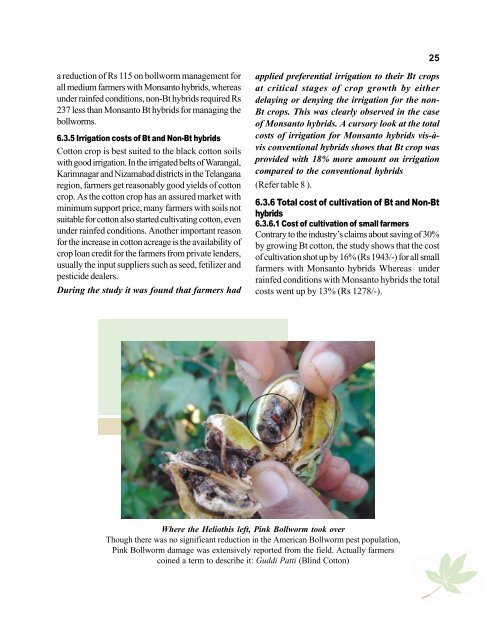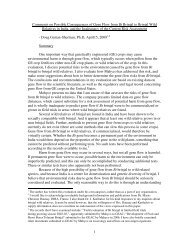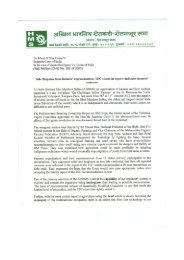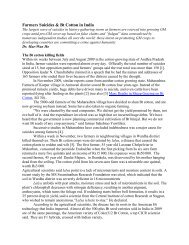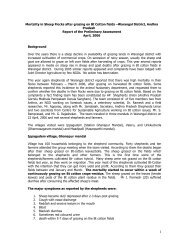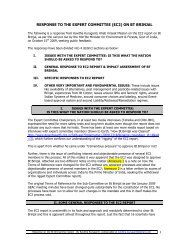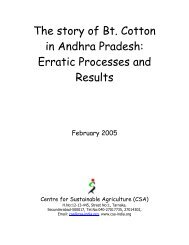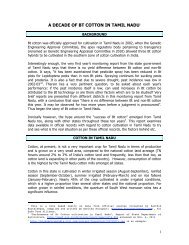Bt cotton in Andhra Pradesh: a three-year assessment - IndiaGMInfo
Bt cotton in Andhra Pradesh: a three-year assessment - IndiaGMInfo
Bt cotton in Andhra Pradesh: a three-year assessment - IndiaGMInfo
You also want an ePaper? Increase the reach of your titles
YUMPU automatically turns print PDFs into web optimized ePapers that Google loves.
25<br />
a reduction of Rs 115 on bollworm management for<br />
all medium farmers with Monsanto hybrids, whereas<br />
under ra<strong>in</strong>fed conditions, non-<strong>Bt</strong> hybrids required Rs<br />
237 less than Monsanto <strong>Bt</strong> hybrids for manag<strong>in</strong>g the<br />
bollworms.<br />
6.3.5 Irrigation costs of <strong>Bt</strong> and Non-<strong>Bt</strong> hybrids<br />
Cotton crop is best suited to the black <strong>cotton</strong> soils<br />
with good irrigation. In the irrigated belts of Warangal,<br />
Karimnagar and Nizamabad districts <strong>in</strong> the Telangana<br />
region, farmers get reasonably good yields of <strong>cotton</strong><br />
crop. As the <strong>cotton</strong> crop has an assured market with<br />
m<strong>in</strong>imum support price, many farmers with soils not<br />
suitable for <strong>cotton</strong> also started cultivat<strong>in</strong>g <strong>cotton</strong>, even<br />
under ra<strong>in</strong>fed conditions. Another important reason<br />
for the <strong>in</strong>crease <strong>in</strong> <strong>cotton</strong> acreage is the availability of<br />
crop loan credit for the farmers from private lenders,<br />
usually the <strong>in</strong>put suppliers such as seed, fetilizer and<br />
pesticide dealers.<br />
Dur<strong>in</strong>g the study it was found that farmers had<br />
applied preferential irrigation to their <strong>Bt</strong> crops<br />
at critical stages of crop growth by either<br />
delay<strong>in</strong>g or deny<strong>in</strong>g the irrigation for the non-<br />
<strong>Bt</strong> crops. This was clearly observed <strong>in</strong> the case<br />
of Monsanto hybrids. A cursory look at the total<br />
costs of irrigation for Monsanto hybrids vis-àvis<br />
conventional hybrids shows that <strong>Bt</strong> crop was<br />
provided with 18% more amount on irrigation<br />
compared to the conventional hybrids<br />
(Refer table 8 ).<br />
6.3.6 Total cost of cultivation of <strong>Bt</strong> and Non-<strong>Bt</strong><br />
hybrids<br />
6.3.6.1 Cost of cultivation of small farmers<br />
Contrary to the <strong>in</strong>dustry’s claims about sav<strong>in</strong>g of 30%<br />
by grow<strong>in</strong>g <strong>Bt</strong> <strong>cotton</strong>, the study shows that the cost<br />
of cultivation shot up by 16% (Rs 1943/-) for all small<br />
farmers with Monsanto hybrids Whereas under<br />
ra<strong>in</strong>fed conditions with Monsanto hybrids the total<br />
costs went up by 13% (Rs 1278/-).<br />
Where the Heliothis left, P<strong>in</strong>k Bollworm took over<br />
Though there was no significant reduction <strong>in</strong> the American Bollworm pest population,<br />
P<strong>in</strong>k Bollworm damage was extensively reported from the field. Actually farmers<br />
co<strong>in</strong>ed a term to describe it: Guddi Patti (Bl<strong>in</strong>d Cotton)


